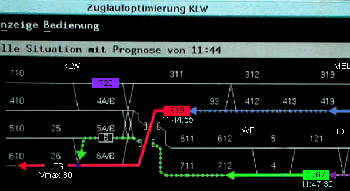
Home > Conflicts > Train speed optimization
Optimization of train speed when approaching a conflict point
SBB is testing a new feature for the first time in Switzerland: optimization of train speed (Zuglaufsoptimierung).
In case of a conflict with an eastbound train coming from Baden, signals automatically instruct a train approading Killwangen from Lenzburg to slow down. This keeps the Lenzburg train from approaching the conflict point at full speed and then having to brake at the last minute.
Here is a screen from the system:
(Click the image for a bigger
version and more details.)
The principle is that the less a train has to slow down, the faster it can return to full speed.
The system entered service on November 5, 2000. Two additional intermediate lineside signals were installed on the eastbound approach to Killwangen from Lenzburg.
Depending on the test results, the density of signals may be similarly increased for eastbound trains coming from Baden. (Another solution would have been to have trains wait in Baden, but then they would occupy platform tracks needed for following trains).
The system optimizes the speed of trains by using the available speed limits of the old-style lineside signals - 40, 60, 90 km/h and full line speed - to slow the trains below the speed required by the standard safety installations, which slow a train no earlier than required for safety.
The system does not automatically change the order in which trains coming from Baden and Lenzburg are scheduled to enter the eastbound express track. Instead, the system notifies the operator (Fahrdienstleiter) in Altstetten, who decides if he wants the trains to move out of scheduled order. On the basis of whatever order the Altstetten operator selects, the system sets each signal for optimum speed.
This site was originally assembled in March 2001. Comments are welcome.
Copyright © 2001-2005 George B. Raymond, Jr. Disclaimer


